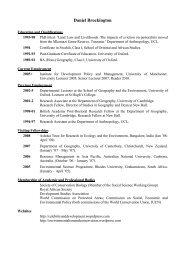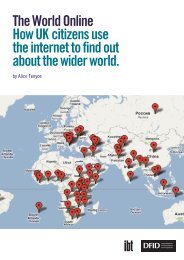World
Viewing the world - Full report
Viewing the world - Full report
- No tags were found...
You also want an ePaper? Increase the reach of your titles
YUMPU automatically turns print PDFs into web optimized ePapers that Google loves.
C. Content StudyC.1.C.1.1.Television News ProfilesSample and MethodTelevision news has the biggest audience of anyprogramme type which routinely covers the developingworld. It is the main source of information about manydeveloping countries for the bulk of the Britishpopulation. Because the developing world featuresrelatively frequently on TV news it was decided toestablish some sense of the pattern of distribution acrossthe major channels over a significant period of time. Theperiod chosen was the first three months of 1999(1 January to 31 March). Although there are likely to bevariations in news which relate to seasonal fluctuationsin climate or in the political cycle, three months does givea reasonable period from which to generalise.The sample included the lunch time, early eveningand main evening bulletins on BBC1 (The One O’clockNews, The Six O’clock News, The Nine o’clock News) and ITV(Lunch Time News, News at 5.40 and News at Ten), ChannelFour News, BBC2’s Newsnight and the two main bulletinson Channel 5. Other areas of programme outputexamined included cable and satellite broadcasting inMarch 1999. The results of this are included in thedetailed analysis of individual news stories and in thestudies of other genres such as travel and cookery whichfollow this section on news profiles.For the purposes of this sample, the developing worldwas defined as all those countries outside of Europe,North America, Japan, Australia and New Zealand andthe countries of Eastern Europe formerly within theSoviet ambit. This amounted to 137 countries. Analphabetical list of these countries can be found in theAppendix: Countries of the developing world.This account was compiled by making use of thecomputerised archives of both the BBC and ITN. The BBCarchive is available commercially and the ITN archive isavailable on the Internet (www.ITNarchive.com). Theseare the archives which the respective companies use toindex all their news output for commercial sale. Thisindicates that they are relatively reliable, but it doesn’tguarantee that absolutely everything which is broadcast isproperly catalogued or retrievable. Nevertheless it doesgive a reasonably good data-set from which to produce anaccount of overall trends in coverage.Both archives were searched under the names of all thecountries in the sample together with conducting anumber of secondary searches. These included firstly,searches on the names of regions or of groups of countriessuch as East Timor or the Windward Islands and secondlya number of searches on stories known to have beenreported which at least partly related to developingcountries, but which may not have mentioned or beenfilmed in developing countries. These included generalstories on debt relief, land-mines, the arms industry,international trade as well as searches for all stories onround-the-world balloon trips and the like, some of whichfeatured reporting from developing countries.The analysis had two key dimensions:● Which countries and which issues and types ofevents were covered. In the first case each countrywas noted even where more than one countryappeared in one news item. For example, reports onthe war in Sierra Leone also featured reports from oron the role of Nigeria and Liberia in the conflict.● In the second part of the analysis, by contrast, eachitem was counted only once. The news was dividedaccording to the type of events which were coveredand which were the main angle of the story. Themain angle of the story was determined in relation tothe headline and the bulk of the report. Where therewas more than one report on the same country, buton differing issues, these were counted separately. Inaddition where the same issue was covered in morethan one report in the same bulletin but each wasfilmed in different countries (such as a visit by aWestern politician to more than one country in oneday) this was also counted separately.C.1.2. ResultsOf the 137 countries of the developing world there wasno discussion or report from 65 of these (See Figure 1). Afurther sixteen countries were mentioned or reported ononly in the context of participation in and hosting ofsporting events, the visits of westerners to thosecountries or stories about animals or the bizarre (SeeFigure 2). For example the only coverage of Kuwait andthe Seychelles was when Tony Blair visited; the onlycoverage of Uruguay was the visit of Prince Charles andthe rescue of a British traveller was the only story fromPapua New Guinea. Mauritania, Western Sahara andSudan featured only because a hot air balloon travelledover these countries as part of a round-the-world-flight.Similarly, the only coverage of Saudi Arabia, Qatar andTrinidad and Tobago was their participation in sporting16 DFID – July 2000





